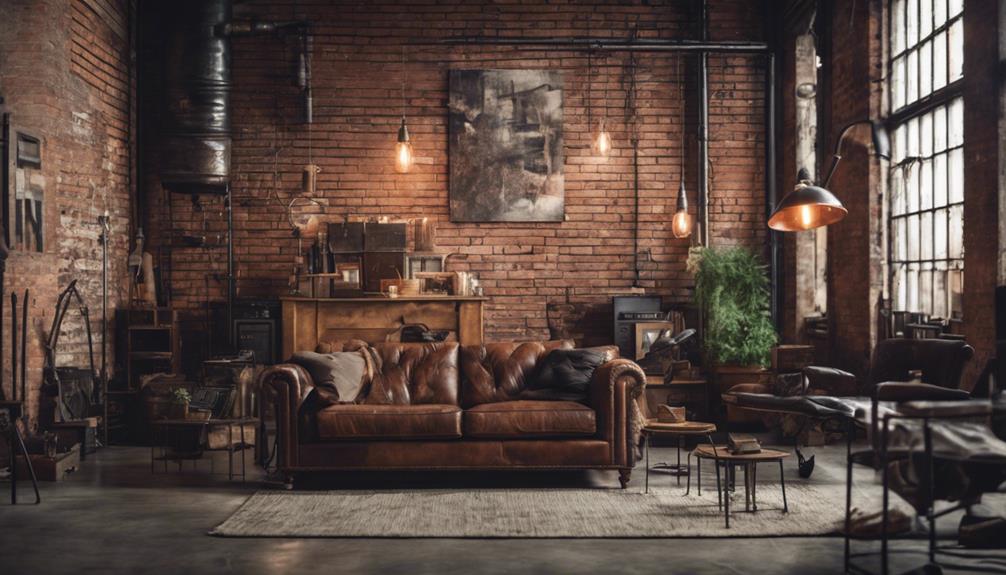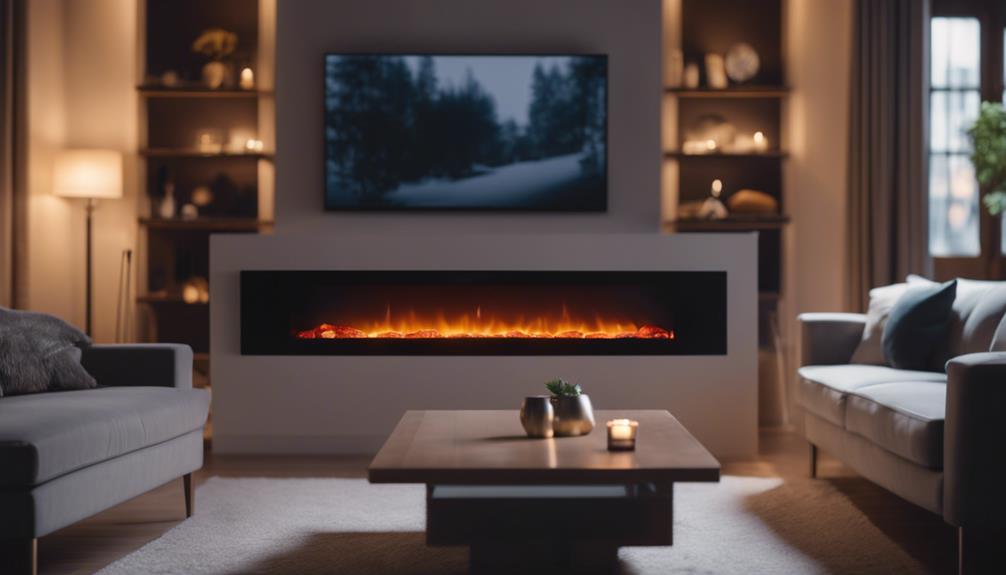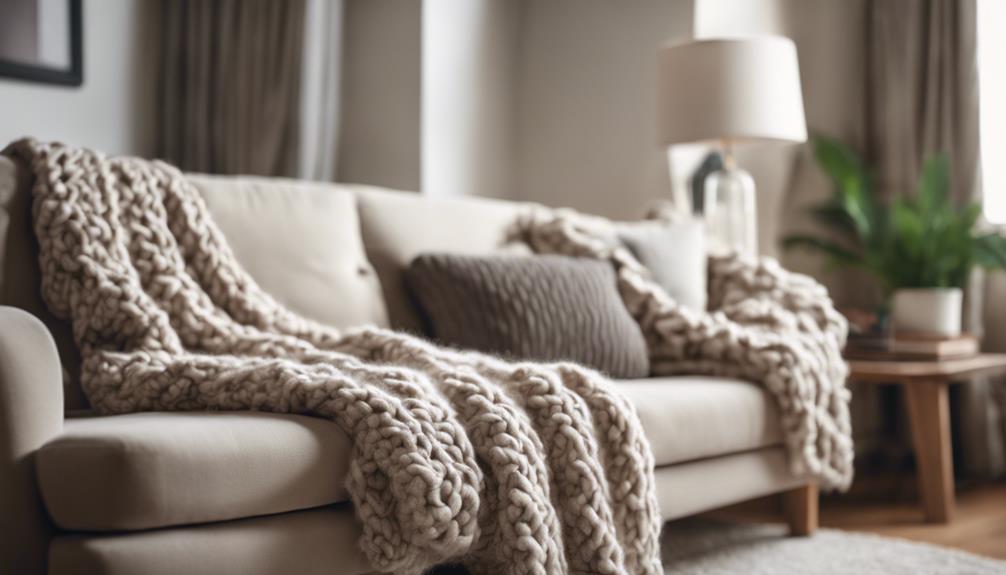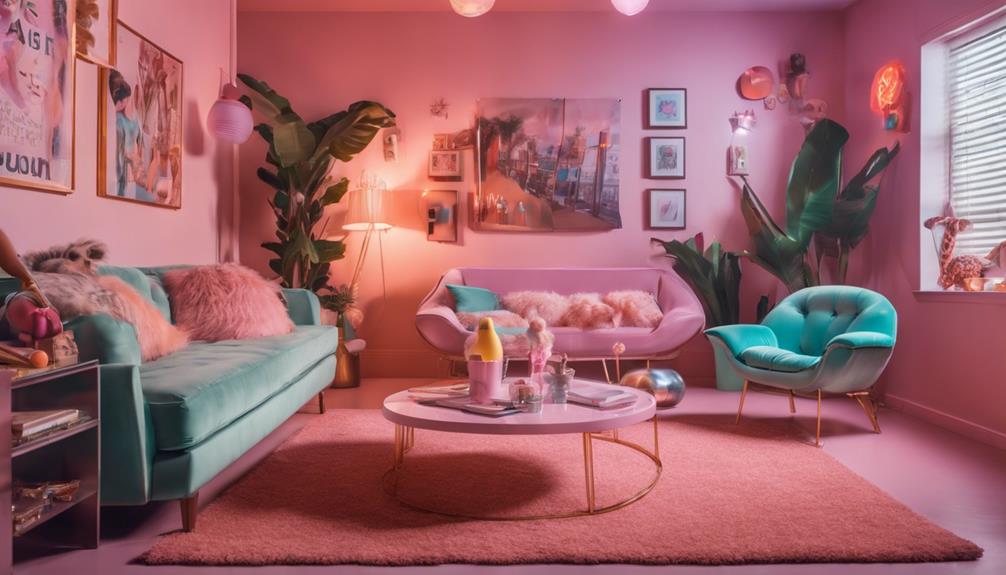Transform your living space into a hip loft oasis with industrial chic decor. Combine exposed concrete and wood floors for a modern yet warm vibe. Embrace bare architecture and neutral walls as a sleek backdrop. Play with earthy monochrome tones and bold accents for added flair. Opt for minimalist furniture with clean lines for a calming atmosphere. Consider open-plan living and kitchen areas for an industrial feel. Mix modern and quirky furniture pieces for a unique touch. Elevate your space with large-scale artwork and leather-linen fabrics. Invite natural light and greenery for a complete urban sanctuary.
Key Takeaways
- Combine exposed concrete and wood floors for a modern and inviting ambiance.
- Use bare architecture and neutral walls to balance warmth and character.
- Incorporate earthy monochrome palette with accents for a stylish look.
- Opt for minimalist design approach with clean lines and neutral colors.
- Create open-plan living and kitchen with industrial elements like brick, concrete, and metal.
Exposed Concrete and Wood Floors
For an industrial chic decor, consider incorporating exposed concrete and wood floors to achieve a modern and inviting ambiance. The rawness of concrete and the warmth of wood can harmonize beautifully in your space.
To enhance this aesthetic, you might want to hang a sleek pendant light above the area where these materials meet. This lighting fixture can act as a focal point, illuminating the textures and colors of the floors while adding a touch of contemporary style.
Exposed concrete floors not only add an industrial touch but are also practical for high-traffic areas due to their durability and easy maintenance. On the other hand, wood floors bring a cozy and contrasting element to the industrial aesthetic, creating a comfortable atmosphere.
Bare Architecture and Neutral Walls
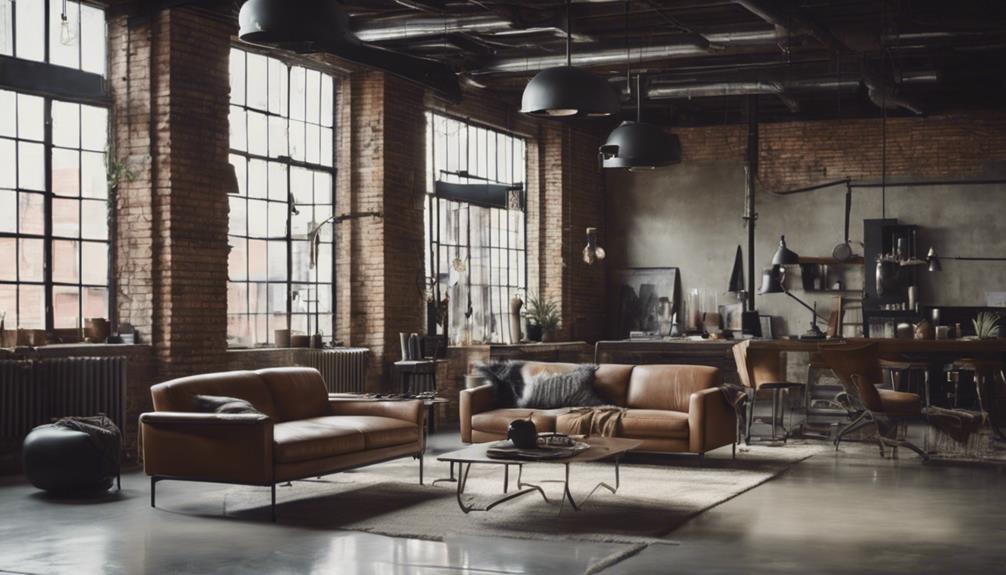
Consider integrating basic architectural elements and neutral walls in your industrial chic decor to achieve a minimalist yet edgy aesthetic. Embrace exposed brick walls, a hallmark of industrial design, to infuse warmth and character into your space while maintaining that raw, industrial vibe. Pair this with exposed ceilings, raw concrete floors, and unfinished walls for a cohesive look that exudes a modern, urban charm.
Neutral walls, in tones like white or gray, serve as the perfect backdrop to showcase the textures and materials of your industrial chic decor. They create a clean canvas that allows the industrial elements to shine while offering flexibility for personalization with accents and decor pieces. This balance guarantees that your space feels both inviting and stylish, blending industrial and modern aesthetics seamlessly.
Earthy Monochrome Palette With Accents
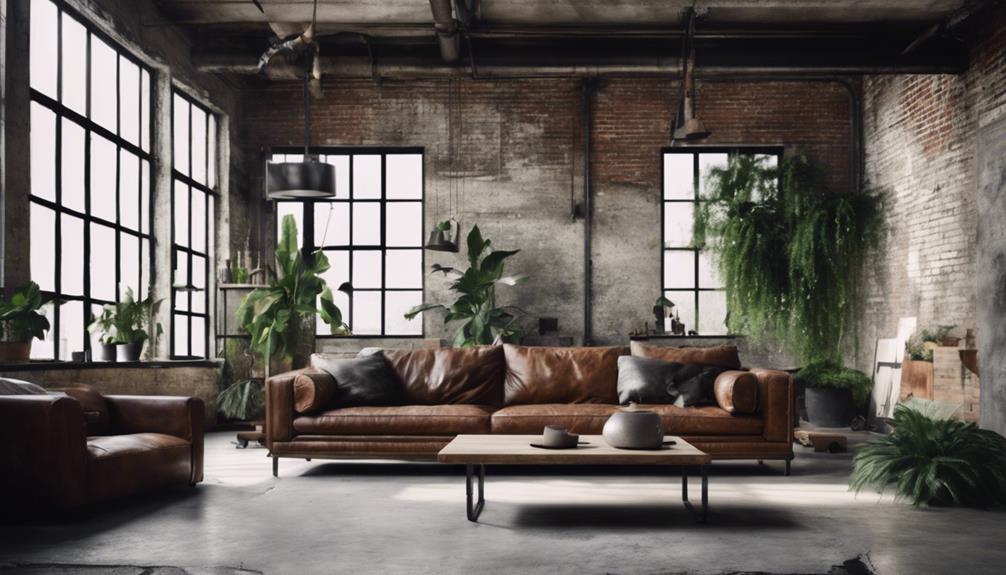
You can enhance your industrial chic decor by carefully selecting accent pieces that complement your earthy monochrome palette.
Consider incorporating bold artwork, metallic fixtures, or colorful textiles to add depth and visual interest to your space.
Accent Pieces Selection
To achieve a harmonious blend of earthy tones with vibrant accents in your Industrial Chic decor, consider incorporating accent pieces that feature pops of color like mustard yellow, rust red, or forest green. These bold hues will stand out against the neutral backdrop of gray, brown, and beige, adding depth and personality to your space.
In addition to colorful accents, don't forget to include metallic elements like copper, brass, or aged metal to infuse an industrial vibe into the mix. For a touch of uniqueness, consider incorporating textured elements such as faux fur throws, rough-hewn wood furniture, or woven baskets. These will enhance the earthy feel of your space while adding layers of visual interest.
To further elevate the Industrial Chic aesthetic, consider adding accent pieces like exposed filament light bulbs, vintage signs, or salvaged architectural pieces for a one-of-a-kind look that truly captures the essence of this style.
Monochrome Palette Tips
Incorporate earthy tones like grey, beige, brown, and black into your industrial chic decor to establish a cohesive monochrome palette with accents that exude natural warmth and rugged elegance.
When creating an earthy monochrome palette with accents in industrial style, consider the following tips:
- Choose Furniture: Opt for sleek grey sofas or beige leather armchairs to anchor your space.
- Add Textures: Incorporate a black metal coffee table with a distressed wood top for an industrial touch.
- Lighting Fixtures: Select matte black pendant lights or bronze sconces to enhance the ambiance.
- Wall Art: Hang black and white photography or abstract art in wooden frames to complement the palette.
- Soft Furnishings: Layer plush grey rugs and beige throw pillows to add comfort and depth to the monochrome setting.
Minimalist Design Approach
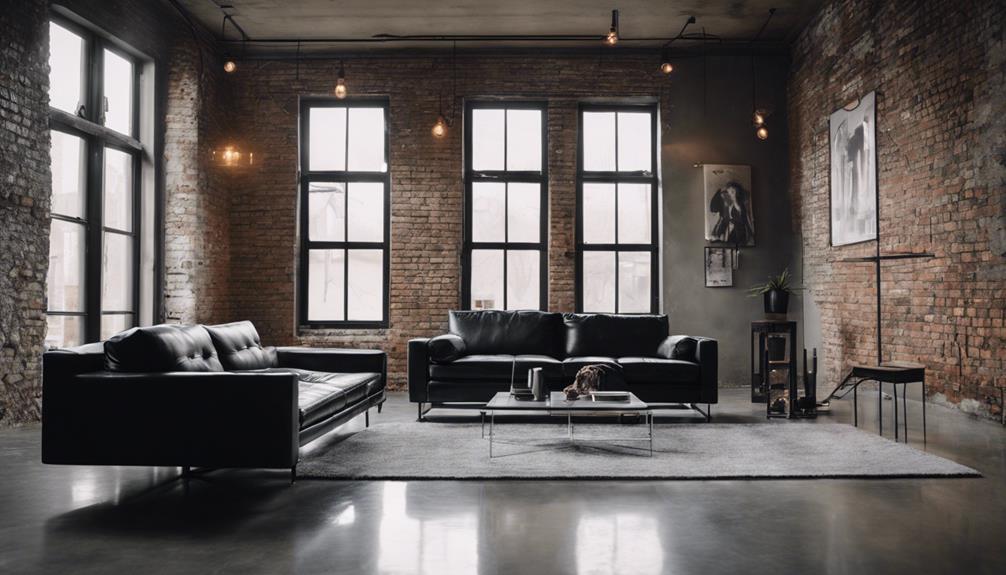
When aiming for a minimalist design approach in industrial chic decor, prioritize simplicity, functionality, and clean lines. By embracing these principles, you can create a space that feels open, airy, and uncluttered.
Opt for a neutral color palette with earthy tones like gray, black, white, and brown to establish a calming and cohesive atmosphere. Incorporate raw textures such as exposed brick walls, concrete floors, and metal fixtures to enhance the industrial feel while maintaining a sense of simplicity.
Select key furniture pieces with sleek designs and minimal ornamentation to complement the minimalist aesthetic. Remember that less is more when it comes to decor items; carefully choose each piece and avoid excessive embellishments to keep the space uncluttered.
Open-Plan Living and Kitchen
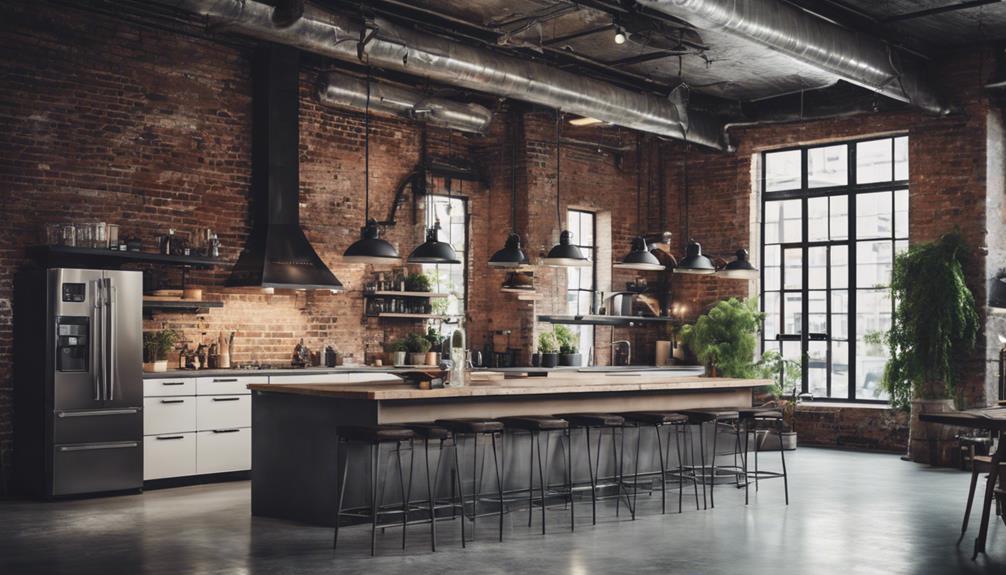
Create a seamless flow between your living and kitchen areas in industrial chic decor by embracing open-plan design principles. This design concept is characterized by spaciousness and connectivity, allowing for a smooth shift between cooking, dining, and lounging spaces.
Here are some key elements to contemplate when integrating an open-plan living and kitchen area:
- Exposed Ceilings: Emphasize the industrial vibe with raw, exposed ceilings that add character to the space.
- Raw Textures: Incorporate materials like brick, concrete, and metal to enhance the industrial aesthetic.
- Minimalistic Furnishings: Opt for sleek, simple furniture pieces to maintain a clean and uncluttered look.
- Abundant Natural Light: Maximize the use of windows and skylights to flood the area with natural light, creating an airy atmosphere.
- Central Kitchen Island: Utilize a kitchen island as a focal point that offers both functionality and a visual anchor in the open-plan layout, perfect for casual dining and socializing.
Modern and Quirky Furniture Mix
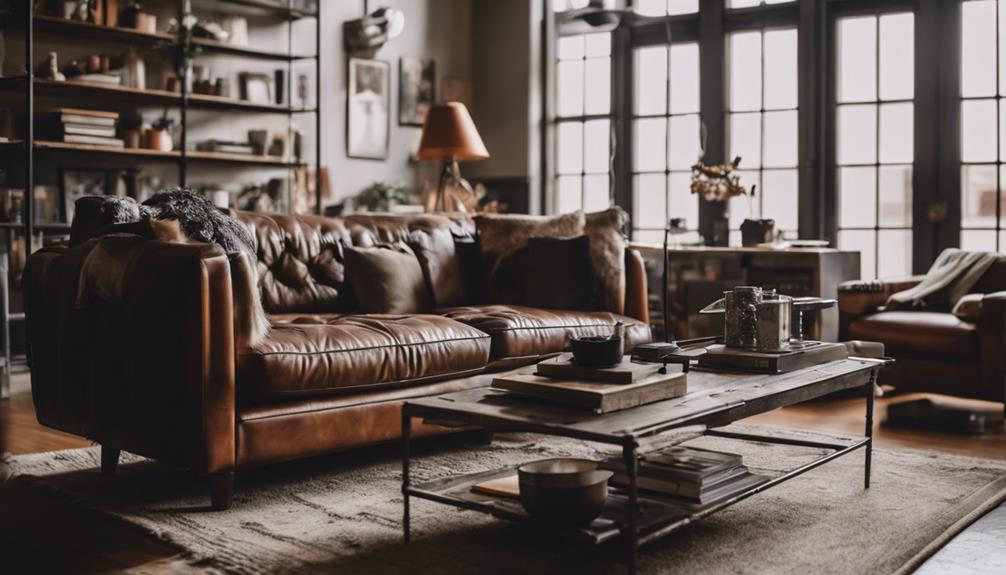
Embrace a modern and quirky furniture mix in your industrial chic decor by blending materials like wood, metal, and glass to infuse a unique aesthetic into your living and kitchen areas.
Opt for furniture pieces with unconventional shapes and unique designs to add personality to your space. Consider incorporating recycled or repurposed items to align with the sustainability aspect of industrial chic style.
To enhance the ambiance, include vintage or industrial-inspired pieces like factory carts or metal shelving units for a touch of nostalgia.
For a contemporary touch, integrate pendant lighting fixtures that complement the modern and quirky furniture mix. These lighting elements not only provide functional illumination but also serve as stylish accents that tie the eclectic furniture pieces together.
Remember to balance the modern and quirky furniture mix with minimalist elements to achieve a cohesive and stylish industrial chic look in your home.
Large-Scale Artwork Display
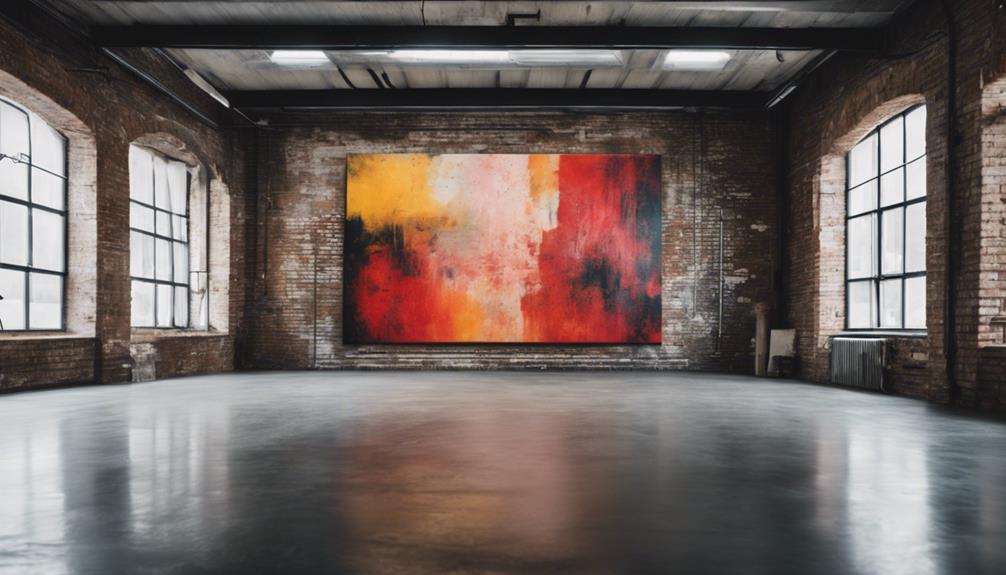
When incorporating large-scale artwork in your industrial chic decor, consider using oversized pieces like paintings or sculptures to create a striking focal point in the room.
These statement artworks can serve as inspiration for creating a gallery wall that adds visual interest and personality to your space.
Art as Focal Point
Large-scale artwork serves as a striking focal point in industrial chic decor, commanding attention and infusing character into the space.
When incorporating art as a focal point in your industrial chic design, consider the following:
- Dramatic Impact: Oversized paintings or photographs can create a sense of drama and visual interest, complementing the raw and minimalist aesthetic of industrial decor.
- Urban Feel: Industrial lofts often showcase industrial-style artwork like metal sculptures or abstract pieces, enhancing the urban vibe of the space.
- Contrast and Harmony: Artwork with bold colors or graphic designs can provide a beautiful contrast to industrial elements such as exposed brick walls or metal fixtures while still harmonizing with the overall theme.
- Personal Expression: Unique art pieces not only elevate the design of the space but also serve as a reflection of your personal style, adding a touch of individuality to the industrial chic setting.
- Conversation Starter: Large-scale artwork can spark conversations and draw the eye, becoming a central point around which the rest of the decor can revolve.
Gallery Wall Inspiration
Incorporate a dynamic mix of artwork to create an engaging and visually alluring gallery wall in your industrial chic decor.
Gallery walls serve as a focal point, often featuring large-scale artwork that makes a bold statement in the space. These walls can showcase a diverse range of art pieces, including paintings, prints, photographs, and even sculptural elements.
The beauty of gallery walls lies in their ability to mix styles, from modern and abstract to vintage and industrial pieces, allowing for personal expression and customization to match your tastes. Popular in industrial chic decor, gallery walls add character and visual interest to the overall aesthetic of the space.
Statement Art Pieces
Enhancing your industrial chic decor with statement art pieces can elevate the visual impact of your space, creating a mesmerizing focal point. Large art pieces have the power to transform a room, adding a touch of sophistication and personality to your loft-style home.
Here are some ways to make a bold statement with oversized artwork:
- Placing a massive abstract painting above a minimalist sofa can draw the eye and create a stunning contrast.
- Hanging a large photograph on a prominent wall can add depth and visual interest to your industrial chic space.
- Opting for a huge graphic print can inject energy and modernity into a room with exposed brick or concrete walls.
- Displaying an oversized sculpture in a corner can create a sense of drama and intrigue in your loft setting.
- Using a large-scale art piece to anchor a gallery wall can tie together the different elements of your industrial chic design, creating a cohesive and visually appealing atmosphere.
Leather and Linen Fabrics
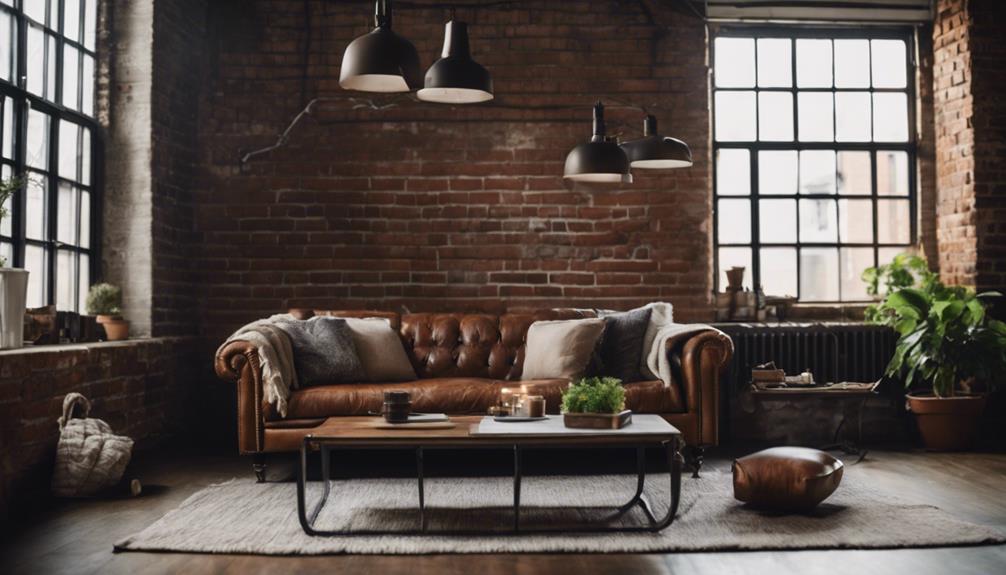
When aiming to infuse industrial chic decor with a touch of luxury, incorporating leather and linen fabrics is key. Leather furniture, such as armchairs or sofas, not only brings a rugged yet elegant aesthetic to industrial loft interiors but also adds a sophisticated touch.
On the other hand, linen fabrics in the form of curtains, throw pillows, or upholstery provide a soft contrast to the raw textures of concrete and steel, enhancing the overall cozy feel of the space.
The combination of leather and linen creates a harmonious balance between industrial elements and cozy comfort in a loft-style home. The durability of leather juxtaposed with the softness of linen adds depth and character to industrial chic decor, making the space visually appealing and inviting.
Abundant Natural Light and Pendant Lighting

You'll love how abundant natural light enhances the industrial chic vibe of your space, creating a bright and welcoming ambiance.
Consider pendant lighting options to add a modern and industrial flair to your decor, with fixtures that complement the overall style.
Strategically placing lighting fixtures near windows and skylights can maximize the impact of natural light and illuminate key features of your industrial loft design.
Natural Light Benefits
Incorporate abundant natural light and pendant lighting to enhance the industrial chic aesthetic of your space. Natural light not only brightens up your home but also brings a sense of spaciousness and airiness that perfectly complements the industrial loft style. Here are a few benefits of embracing natural light in your industrial chic decor:
- Energy Efficiency: Natural light helps reduce energy consumption, making your space more environmentally friendly.
- Sustainable Living: By utilizing natural light, you contribute to a more sustainable living environment in your industrial chic home.
- Warm Ambiance: Pendant lighting fixtures, paired with natural light, create a warm and inviting glow in your industrial chic space.
- Cozy Atmosphere: The combination of natural light and pendant lighting fosters a cozy and welcoming atmosphere in your industrial chic loft.
- Highlighting Aesthetics: Natural light and pendant lighting work together to accentuate the raw and minimalist aesthetic of loft living, elevating the overall look and feel of your space.
Pendant Light Options
To enhance the industrial chic style of your space, consider incorporating pendant light options that provide ambient lighting and serve as a statement piece in the room.
Pendant lights, available in styles like cage, industrial, or vintage designs, can add character to your space, making it truly unique. These lights are versatile and work well in various areas such as kitchen islands, dining spaces, or living rooms, seamlessly blending with your industrial chic decor.
Pairing pendant lights with abundant natural light creates a warm and inviting ambiance in your loft-style home. The right choice of pendant light can perfectly complement your industrial chic decor, accentuating the raw textures and exposed elements of the space.
Lighting Placement Tips
Position your furniture strategically to take full advantage of abundant natural light, creating a bright and airy atmosphere in your industrial chic space. To enhance the lighting in your home, consider the following tips:
- Hang pendant lighting fixtures above key areas such as dining tables or kitchen islands to create focal points and improve functionality.
- Combine the use of natural light and pendant lighting to establish a harmonious and inviting ambiance that complements the industrial loft style.
- Experiment with a variety of shapes, sizes, and finishes of pendant lights to infuse personality and visual interest into the space.
- Make sure that pendant lights are placed at an appropriate height to prevent glare and provide adequate illumination.
- Use pendant lighting to highlight specific features of your industrial chic decor, such as exposed brick walls or metal accents, adding to the overall aesthetic appeal of the space.
Greenery Accents With Plants
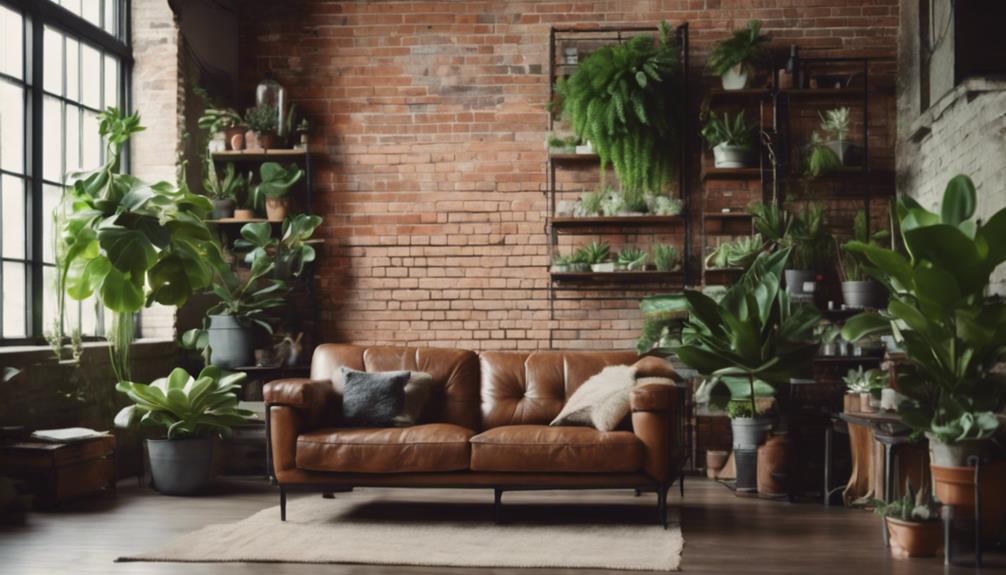
Enhance your industrial chic decor by infusing greenery accents with plants to bring a touch of nature indoors. Greenery accents not only soften the raw textures of industrial elements but also add warmth and life to your space. Plants aren't just decorative but also beneficial, improving indoor air quality by absorbing toxins and releasing oxygen, creating a healthier environment for you to enjoy.
For your industrial loft setting, consider incorporating low-maintenance options like succulents, air plants, or other varieties that thrive in urban environments with minimal care. Hanging plants in macrame planters or strategically placing potted plants on shelves and tables can introduce pops of color and vibrancy to your industrial chic aesthetic.
Furthermore, greenery accents with plants can contribute to the ambiance of tranquility and relaxation in your industrial loft, harmonizing the industrial features with natural beauty. Embrace the calming influence of nature within your urban space through thoughtful placement of greenery accents.
Frequently Asked Questions
How to Make a House Feel Like a Loft?
To make your house feel like a loft, divide spaces with bookcases or screens. Use soft materials for warmth. Choose cozy furniture like sectional sofas. Maximize natural light and add warm lighting. Include urban elements like exposed beams and brick walls.
What Is the Difference Between Loft and Industrial Design?
So, what sets loft and industrial design apart? Lofts strike a balance between cozy comfort and modern style, while industrial spaces exude rugged charm with raw materials. The key? Lofts feel like home; industrials feel like a gritty warehouse.
What Is Industrial Loft Style?
Industrial loft style merges industrial elements like metal fixtures and raw textures with minimalism. Exposed beams, brick walls, and spacious layouts define it. Add cozy furniture and focus on lighting to make it feel like home.
How to Make an Industrial Loft Cozy?
To make an industrial loft cozy, pile on soft rugs, warm lights, and comfy furniture. Divide your space with bookcases for intimacy. Let in natural light and add warm lighting. Transform your cool loft into a snug nest.
Conclusion
So there you have it – with a touch of industrial chic decor, your home will be transformed into a cool and trendy loft in no time.
Embrace the exposed concrete, minimalist design, and earthy tones to create a modern and stylish space that's sure to impress.
Add in some large-scale artwork, leather and linen fabrics, and plenty of natural light to complete the look.
Your friends will be green with envy over your hip new living space!
